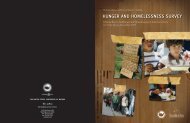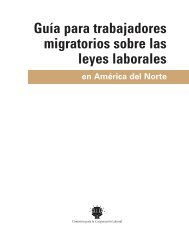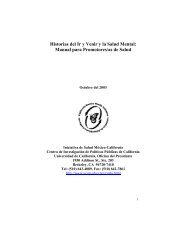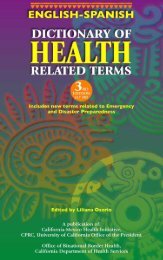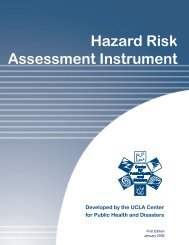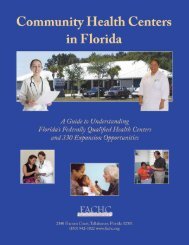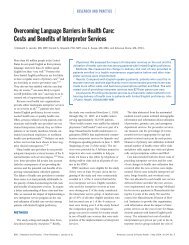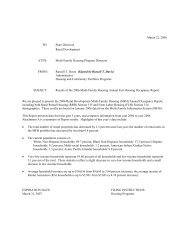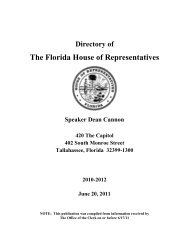Self-Assessment Checklist for Personnel Providing Primary Health ...
Self-Assessment Checklist for Personnel Providing Primary Health ...
Self-Assessment Checklist for Personnel Providing Primary Health ...
You also want an ePaper? Increase the reach of your titles
YUMPU automatically turns print PDFs into web optimized ePapers that Google loves.
<strong>Self</strong>-<strong>Assessment</strong> <strong>Checklist</strong> <strong>for</strong> <strong>Personnel</strong> <strong>Providing</strong> <strong>Primary</strong> <strong>Health</strong> Care<br />
Services<br />
Tawara D. Goode, - Georgetown University Center <strong>for</strong> Child and Human<br />
Development- Adapted from Promoting Cultural and Linguistic Competence and<br />
Cultural Diversity in Early Intervention and Early Childhood Settings and Promoting<br />
Cultural Competence and Cultural Diversity <strong>for</strong> <strong>Personnel</strong> <strong>Providing</strong> Services and<br />
Supports to Children with Special <strong>Health</strong> Care Needs and their Families- (June,1989;<br />
revised 1993; revised 1996; 1997; 1999; 2000; and 2002).<br />
Directions:<br />
Please select A, B, or C <strong>for</strong> each item listed below.<br />
• A = Things I do frequently<br />
• B = Things I do occasionally<br />
• C = Things I do rarely or never<br />
PHYSICAL ENVIRONMENT, MATERIALS & RESOURCES<br />
1. _____ I display pictures, posters, artwork and other decor that reflect the<br />
cultures and ethnic backgrounds of clients served by my program or agency.<br />
2. _____ I ensure that magazines, brochures, and other printed materials in<br />
reception areas are of interest to and reflect the different cultures of<br />
individuals and families served by my program or agency.<br />
3. _____ When using videos, films or other media resources <strong>for</strong> health<br />
education, treatment or other interventions, I ensure that they reflect the<br />
cultures and ethnic background of individuals and families served by my<br />
program or agency.<br />
4. _____ I ensure that printed in<strong>for</strong>mation disseminated by my agency or<br />
program takes into account the average literacy levels of individuals and<br />
families receiving services.<br />
COMMUNICATION STYLES<br />
5. When interacting with individuals and families who have limited English<br />
proficiency I always keep in mind that:<br />
o _____ limitations in English proficiency is in no way a reflection of<br />
their level of intellectual functioning.<br />
o _____ their limited ability to speak the language of the dominant<br />
culture has no bearing on their ability to communicate effectively in<br />
their language of origin.<br />
o * _____ they may or may not be literate in their language of origin<br />
or English.<br />
6. _____ I use bilingual-bicultural staff and/or personnel and volunteers<br />
skilled or certified in the provision of medical interpretation during treatment,<br />
interventions, meetings or other events <strong>for</strong> individuals and families who need<br />
or prefer this level of assistance.
7. _____ For individuals and families who speak languages or dialects other<br />
than English, I attempt to learn and use key words in their language so that I<br />
am better able to communicate with them during assessment, treatment or<br />
other interventions.<br />
8. _____ I attempt to determine any familial colloquialisms used by<br />
individuals or families that may impact on assessment, treatment or other<br />
interventions.<br />
9. _____ When possible, I ensure that all notices and communiqués to<br />
individuals and families are written in their language of origin.<br />
10. _____ I understand that it may be necessary to use alternatives to written<br />
communications <strong>for</strong> some individuals and families, as word of mouth may be<br />
a preferred method of receiving in<strong>for</strong>mation.<br />
VALUES & ATTITUDES<br />
11. _____ I avoid imposing values which may conflict or be inconsistent with<br />
those of cultures or ethnic groups other than my own.<br />
12. _____ I screen books, movies, and other media resources <strong>for</strong> negative<br />
cultural, ethnic, or racial stereotypes be<strong>for</strong>e sharing them with individuals and<br />
families served by my program or agency.<br />
13. _____ I intervene in an appropriate manner when I observe other staff or<br />
clients within my program or agency engaging in behaviors which show<br />
cultural insensitivity, racial biases and prejudice.<br />
14. _____ I recognize and accept that individuals from culturally diverse<br />
backgrounds may desire varying degrees of acculturation into the dominant<br />
culture.<br />
15. _____ I understand and accept that family is defined differently by<br />
different cultures (e.g. extended family members, fictive kin, godparents).<br />
16. _____ I accept and respect that male-female roles may vary significantly<br />
among different cultures and ethic groups (e.g. who makes major decisions<br />
<strong>for</strong> the family).<br />
17. _____ I understand that age and life cycle factors must be considered in<br />
interactions with individuals and families ( e.g. high value placed on the<br />
decision of elders, the role of eldest male or female in families, or roles and<br />
expectation of children within the family).<br />
18. _____ Even though my professional or moral viewpoints may differ, I<br />
accept individuals and families as the ultimate decision makers <strong>for</strong> services<br />
and supports impacting their lives.<br />
19. _____ I recognize that the meaning or value of medical treatment and<br />
health education may vary greatly among cultures.<br />
20. _____ I accept that religion and other beliefs may influence how<br />
individuals and families respond to illnesses, disease, and death.
21. _____ I understand that the perception of health, wellness and preventive<br />
health services have different meanings to different cultural or ethnic groups.<br />
22. _____ I recognize and accept that folk and religious beliefs may influence<br />
an individual’s or family’s reaction and approach to a child born with a<br />
disability, or later diagnosed with a disability, genetic disorder, or special<br />
health care needs.<br />
23. _____ I understand that grief and bereavement are influenced by culture.<br />
24. _____ I seek in<strong>for</strong>mation from individuals, families or other key community<br />
in<strong>for</strong>mants that will assist in service adaptation to respond to the needs and<br />
preferences of culturally and ethnically diverse groups served by my program<br />
or agency.<br />
25. _____ Be<strong>for</strong>e visiting or providing services in the home setting, I seek<br />
in<strong>for</strong>mation on acceptable behaviors, courtesies, customs, and expectations<br />
that are unique to the culturally and ethnically diverse groups served by my<br />
program or agency.<br />
26. _____ I keep abreast of the major health concerns and issues <strong>for</strong><br />
ethnically and racially diverse client populations residing in the geographic<br />
locale served by my program or agency.<br />
27. _____ I am aware of the socio-economic and environmental risk factors<br />
that contribute to health disparities and/or major health problems of<br />
culturally, ethnically and racially diverse populations served by my program or<br />
agency.<br />
28. _____ I am well versed in the most current and proven practices,<br />
treatments and interventions <strong>for</strong> major health problems among ethnically and<br />
racially diverse groups within the geographic locale served by my agency or<br />
program.<br />
29. _____ I avail myself to professional development and training to enhance<br />
my knowledge and skills in the provision of services and supports to<br />
culturally, ethnically, racially and linguistically diverse groups.<br />
30. _____ I advocate <strong>for</strong> the review of my program's or agency's mission<br />
statement, goals, policies, and procedures to ensure that they incorporate<br />
principles and practices that promote cultural and linguistic competence.<br />
How to use this checklist<br />
This checklist is intended to heighten the awareness and sensitivity of personnel to<br />
the importance of cultural and linguistic cultural competence in health and human<br />
service settings. It provides concrete examples of the kinds of beliefs, attitudes,<br />
values and practices which foster cultural and linguistic competence at the individual<br />
or practitioner level. There is no answer key with correct responses. However, if you<br />
frequently responded "C", you may not necessarily demonstrate beliefs, attitudes,<br />
values and practices that promote cultural and linguistic competence within health<br />
care delivery programs.



